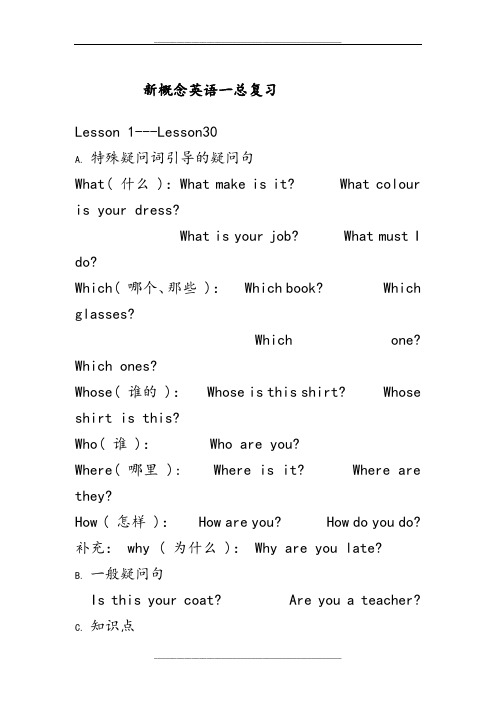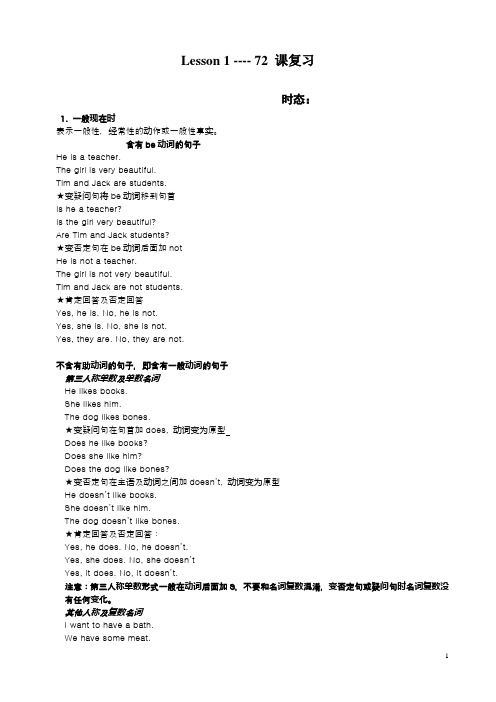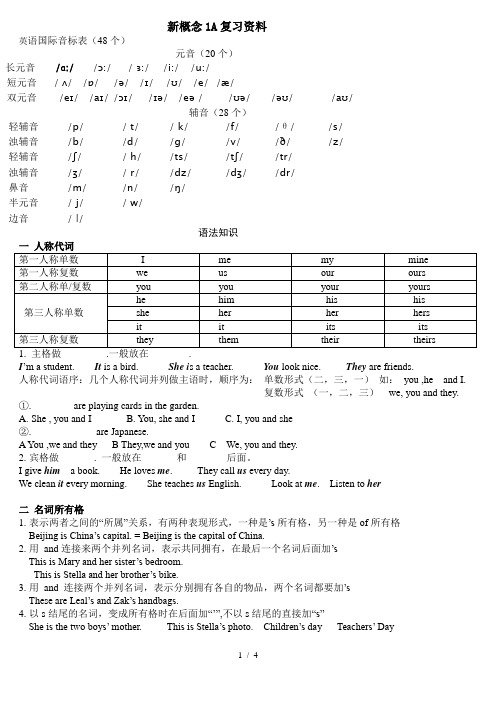新概念英语第一册 期末复习资料
新概念英语一总复习

新概念英语一总复习Lesson 1---Lesson30A.特殊疑问词引导的疑问句What( 什么 ):What make is it? What colouris your dress?What is your job? What must Ido?Which( 哪个、那些 ): Which book? Which glasses?Which one? Which ones?Whose( 谁的 ): Whose is this shirt? Whoseshirt is this?Who( 谁 ): Who are you?Where( 哪里 ): Where is it? Where arethey?How ( 怎样 ): How are you? How do you do?补充: why ( 为什么 ): Why are you late?B.一般疑问句Is this your coat? Are you a teacher?C.知识点1.人称物主代词:名词性物主代词:形容词物主代词:2.方位介词(1):翻译在厨房里()在桌子上()在房子的中间()在墙上()在门旁()在左边()在右边()3.There be 句型和冠词( a , an, the ): 改错1】This not is me house.2】Is that you car?3】Is it her handbag? No, it is my.4】The book is her.5】Here are your shirt.6】Look! There is a postmen.7】There is a empty bottles on table.8】Are there any tickets in the shelf?9】The stereo near the door.Lesson 31---Lesson60A.There be 句型单数肯定句:There is some milk in the bottle.单数否定句:There isn`t any milk in the bottle.单数疑问句: Is there any milk in the bottle?模仿练习:分别将上面的三句话变成复数肯定句,复数否定句,和附属疑问句。
新概念英语第一册 Lesson 1--73 复习资料

Lesson 1 ---- 72 课复习时态:1. 一般现在时表示一般性,经常性的动作或一般性事实。
含有be动词的句子He is a teacher.The girl is very beautiful.Tim and Jack are students.★变疑问句将be动词移到句首Is he a teacher?Is the girl very beautiful?Are Tim and Jack students?★变否定句在be动词后面加notHe is not a teacher.The girl is not very beautiful.Tim and Jack are not students.★肯定回答及否定回答Yes, he is. No, he is not.Yes, she is. No, she is not.Yes, they are. No, they are not.不含有助动词的句子,即含有一般动词的句子第三人称单数及单数名词He likes books.She likes him.The dog likes bones.★变疑问句在句首加does, 动词变为原型Does he like books?Does she like him?Does the dog like bones?★变否定句在主语及动词之间加doesn’t, 动词变为原型He doesn’t like books.She doesn’t like him.The dog doesn’t like bones.★肯定回答及否定回答:Yes, he does. No, he doesn’t.Yes, she does. No, she doesn’tYes, it does. No, it doesn’t.注意:第三人称单数形式一般在动词后面加S,不要和名词复数混淆,变否定句或疑问句时名词复数没有任何变化。
新概念英语一-1-36课语法知识点总结复习以及相应习题

新概念1A复习资料英语国际音标表(48个)元音(20个)长元音/ɑ:/ /ɔ:// ɜ://i://u:/短元音/ ʌ//ɒ//ə//ɪ//ʊ//e//æ/双元音/eɪ/ /aɪ//ɔɪ/ /ɪə//eə / /ʊə//əʊ//aʊ/辅音(28个)轻辅音/p// t// k//f//θ//s/浊辅音/b//d/ /g//v//ð/ /z/轻辅音/ʃ// h//ts//tʃ//tr/浊辅音/ʒ// r/ /dz/ /dʒ//dr/鼻音/m//n/ /ŋ/半元音/ j// w/边音/ ǀ/语法知识I’m a student. It is a bird. She i s a teacher. You look nice. They are friends.人称代词语序:几个人称代词并列做主语时,顺序为:单数形式(二,三,一)如:you ,he and I.复数形式(一,二,三)we, you and they.①.________ are playing cards in the garden.A.She , you and IB. You, she and IC. I, you and she②. ____________ are Japanese.A You ,we and theyB They,we and youC We, you and they.2.宾格做_______. 一般放在_______和________后面。
I give him a book. He loves me. They call us every day.We clean it every morning. She teaches us English. Look at me. Listen to her二名词所有格1.表示两者之间的“所属”关系,有两种表现形式,一种是’s所有格,另一种是of所有格Beijing is China’s capital. = Beijing is the capital of China.2.用and连接来两个并列名词,表示共同拥有,在最后一个名词后面加’sThis is Mary and her sister’s bedroom.This is Stella and her brother’s bike.3.用and 连接两个并列名词,表示分别拥有各自的物品,两个名词都要加’sThese are Leal’s and Zak’s handbags.4.以s结尾的名词,变成所有格时在后面加“’”,不以s结尾的直接加“s”She is the two boys’ mother. This is Stella’s photo.Children’s day Teachers’ Day5 of形式的所有格The door of the room He is a friend of mine. He is a friend of my brother’s.三特殊疑问句引导词what什么答事物,who问谁来答人名,whose谁的表归属what color问颜色what’s …job问工作when问时间答时间,where 在哪答地点,which哪一任你选, how身体健康What nationality…问国籍What’s the matter..?问健康四冠词冠词有三个,不定冠词a/an, 定冠词the冠词用在名词的前面。
新概念英语第一册复习一

第一篇基本词句一、基本句子(牢记):Excuse me!不好意思!打拢了——Is this your handbag? 这是你的手提包吗?——Yes,it is. 是,这是我的手提包。
——No,it isn't. 不,这不是我的手提包。
——How are you today? 你今天感觉如何?——I'm fine,thank you. 我很好,谢谢你。
How do you do? 您好(初次见面,正式打招呼时)——Nice to meet you. 很高兴认识你。
——Nice to meet you,too. 我也是。
——what is your job? 你有职业是什么?——I am an English teacher. 我是一名英语老师。
——what colour is your dress? 你的裙子是什么颜色?——My dress is blue. 我的裙子是蓝色的。
——Are you French? 你是法国人吗?——Yes,I am. 是的,我是法国人。
——No,I am not. 不,我不是。
——What nationality are you? 你的国籍是哪里?——I am French. 我是法国人。
——I am American. 我是美国人。
——Which one? 哪一个?——The red one. 红色的那个。
——Which ones? 哪些?——The red ones. 红色的那些。
——Where is it? 它在哪里?——It's on the desk. 它在书桌上。
——Where are they? 他们在哪里?——They are in the kitchen. 他们在厨房。
What's the weather like today? 今天天气如何?What's he/she/it doing? 他/她/它在做什么?——What's are they doing?他们正在做什么?——They are doing their homework.他们正在做家庭作业。
新概念一L1-144复习

Lesson 1-144
牛津英语内容
When is • 1.人称代词your birthday? Where is you she he 主格: I wemy ball pen? it they Why me us like her him 宾格: do you you summer?it them How many books are there in the 形容词性物主代词:my our your her his its school bag? their How old is the young man? 名词性物主代词: mine ours yours hers hisHowtheirs is the toy bear? its much How do you go to school everyday ?
Lesson 1-144
Lesson 1-144
牛津英语内容 4. 规则动词过去式
worked • 1.人称代词 work want 主格: I we you shewanted he it they 宾格: me study her him it them us you studied 形容词性物主代词:my our your her his its opened open their stayed stay 名词性物主代词: mine ours yours hers stopped stop his its theirslive lived like liked watch watched
情态动词 当句子的谓语动词是情态动词时,不论句子的主语 是什么人称和数,情态动词及情态动词之后的动 词全部用动词原形形式。 其他现象 1.当everyone等不定代词/不可数名词作主语时,谓 语要用单数形式; 2.当主语是trousers/people等复数名词时,谓语动 词使用复数形式; 3.当family/class指整体而言时,谓语动词要使用单 数形式;若是指具体的成员时,谓语动词要使用 复数形式。 4.时间/距离/数据/句子作主语时,谓语动词要使用 单数形式。
新概念一册总复习

表示转折的常用表达:但是、 然而、不过等。
写作常见问题分析
段落不连贯
有些学生在写作中,段落之间缺乏过 渡和连贯,导致文章显得生硬不流畅 。
句子结构单一
有些学生的句子结构过于单一,通篇 都是简单句,缺乏变化和丰富性。
用词不当
有些学生在写作中,会出现用词不当 的情况,比如用错名词、动词等。
时态错误
有些学生在写作中,会出现时态错误 的情况,比如过去时态和现在时态混 淆。
流畅的表达能够增强听者 的理解度,要尽量避免语 法错误和停顿。
口语常用表达复习
日常问候
复习常用的日常问候语,如“你 好”、“再见”、“谢谢”等。
自我介绍
掌握自我介绍的基本要素,包括 姓名、年龄、职业等。
表达需求
学会用礼貌的语言表达自己的需 求,如“我要一杯咖啡”等。
口语常见问题分析
语法错误
常常因为紧张或粗心而犯语法错 误,要加强语法知识的复习。
单元五:冠词和数词
冠词
冠词是用来修饰名词或者代词的词,分为不定冠词(a/an) 和定冠词(the)。例如:a book(一本书)、the cat(这 只猫)。
数词
数词是用来表示数量或者顺序的词。例如:one(一)、two (二)、first(第一)等。
02
语法复习
动词时态和语态
动词时态
复习动词时态,包括现在时、过去时、 将来时,理解不同时态的意义和用法。
VS
动词语态
掌握动词的进行体、完成体、完成进行体 等语态,理解不同语态的意义和用法。
情态动词和助动词
情态动词
掌握常用的情态动词,如can、may、must、should等,理解其意义和用法。
助动词
新概念第一册L1-72_复习
自然界:sky bridge valley hill bank weather climate 身体部位:tongue 量词短语:a pound of, half a pound of , a quarter of , a bunch of 国家-国籍: country ——nationality China—Chinese Japan—Janpanese England—English America—American Korea—Korean Russia—Russian France—French Germany—German Brazil—Brazilian Holland—Dutch Italy—Italian Norway—Norwegian Spain—Spanish Sweden—Swedish Australia— Australian Austra—Austrian Canada—Canadian Finland—Finnish India—Indian Nigeria—Nigerian Turkey—Turkish Poland—Polish Thailand—Thai 其他 size crowd
19, A big man ------ a large man 大人物/ 个高的人 20, The books on the shelf 架子上的那些书 the teacher in the classroom 教室里的老师/ /the man in the hat戴着帽子的男人/ /the smile on my face/我脸上的微笑 a boy with glasses / /戴着眼镜的男孩 a girl in my heart /我心中的女孩 21, On the wall 在墙上/ / on the right /left 在右边/在左边/ in the middle of /在…中间/ near the window /靠近窗户 22, What must I do? 我应该做些什么? Must 表示不可逃避的义务或是不可推缷的责任。 23, Make the bed /the tea/coffee/ friend/bookcase/money 铺床/沏茶/煮 咖啡/交朋友/做书架/赚钱 24, Shut /open the door 关/开门 打开或关上具体物,如门,窗等 25, Put on /take off the shirt 穿上/脱下午衬衫 如果是代词可以放在中间 例如: put it on 强调进行的动作 wear a shirt 穿着衬衫 表示状态 26, Turn on /turn off (the stero ) 开 / 关 (立体音响 ) 打开或关上 的是抽象物体及电器;比如水,电
新概念英语第一册NCE1第1-70课复习
He comes from China.
• 3.What's his nationality? (What
nationality is he?) He’s Chinese.
常见国家国籍
• China • Japan • England • America • France • Italy
现在进行时
• 肯定句
• 变否定句在be动词后面加 not
We are having lunch.
We are not having lunch.
He is reading a book.
He is not reading a book.
The dog is running after a cat. The dog is not running after a cat.
• 含有be动词的句子, 将be动词变为
过去式,am, is的过去式为was, are的过去式为were
I was at the butcher’s.
You were a student a year ago.
The teacher was very beautiful ten years ago.
friends.
*变否定句在be动词后面加not He is not a teacher. The boy is not very fat. Lily and Lucy are not good
friends.
一般现在时
*变一般疑问句将be动词移到句首
He is a teacher. The boy is very fat. Lily and Lucy are good friends.
新概念英语第一册总复习
so, neither
I saw Ann yesterday. (我也看见了。) So did I. I’ve got some small change.(他也有。) So has he. I can’t speak French.(她也不会。) Neither can she. Jack doesn’t go to school on foot.(他的哥哥也不.) Neither does his elder brother.
often nev_f_t_en__ late for work so the boss is angry with her.
2. I _n_e_v_e_r_ go swimming in summer. 3. She always shaves in the morning.(改为否定句)
1. I came back last night. When did you come back?
疑问副词
2. I live in the country at present. Where do you live at present?
3. I often go to school on foot. How do you go to school?
副词
时间副词
before/ ago now/then
1. We had some shoes like those a month _a_g_o___. 2. He had never seen that film b_e_f_o_r_e_. 3. She had washed her hands_b_e_fo_r_e_ he had breakfast. 4. What are you going to do_n_o_w___ , George? 5. I was having a party _th_e_n___. 6. ‘I’m listening to the radio now’, she said.(改为间接引语)
新概念一册1-36复习资料
《新概念》一册L1-36课综合复习资料★★★★★礼貌用语你会吗?★★★★★1、想引起对方注意:5、初次见面问候:2、请别人重复所说的话:6、老朋友见面问候身体状况:3、做错事道歉:7、在存放处想取回自己的手提包:4、表示感谢:★★★★★背诵句型:(1--36)(英汉互译)★★★★★1、-打扰一下,请问这个是你的手提包吗?-是的,是我的。
2、请把我的大衣和我的雨伞给我。
3、这是我的票。
4、这不是我的房子。
5、-这是你的手表吗?-不,不是。
6、很高兴见到你。
7、这位是Sophie,她是法国人,她是个法国学生。
8、你的车是什么牌子的?9、那是辆美国制造的车还是意大利制造的车?10、Naoko是日本人还是韩国人?11、他是哪国人?12、-你是做什么工作的?-我是工程师。
13、-Tony今天好吗?-他很好。
14、-那是谁的衬衫?-可能是Tim的。
15.--Are your friends Danish,too?--No,they aren't.16.Y our passports,please.17.--What color are your shirts?--Our shirts are not blue.They are white.e and meet our employees.19.What are their jobs?20.What's the matter,children?21.Are you all right now?22.There is an ice cream man.23.L ook at those hairdressers.24.-Give me a book please.-Which one?-The red one.25.-Which glasses?-The ones on the shelf.26.Here you are.27.There is a refrigerator in the kitchen.28.There are some armchairs near the table.29.The boy is swimming in the river.30.Some children are coming out of the building.31.Some of them are going into the park.32.My wife and I are walking along the banks of the river.33.What's she doing?34.Here is a photograph of our village.练习:根据上下文完成下列对话。
- 1、下载文档前请自行甄别文档内容的完整性,平台不提供额外的编辑、内容补充、找答案等附加服务。
- 2、"仅部分预览"的文档,不可在线预览部分如存在完整性等问题,可反馈申请退款(可完整预览的文档不适用该条件!)。
- 3、如文档侵犯您的权益,请联系客服反馈,我们会尽快为您处理(人工客服工作时间:9:00-18:30)。
新概念英语-期末复习重点内容归纳
1.牢记下列反义词组。
Fat – thin woman – man hot – cold tall – short old – young Busy – lazy dirty – clean big – small long – short shut – open Grandmother – grandfather mother – father heavy – light 2.常用交际用语。
(1)Thank you very much ! (非常感谢)
(2)You are welcome .(不用谢)
(3)Here you are .(给你)
(4)Your ticket , please. (请出示你的票)
(5)What’s the matter ? (你怎么啦)
(6)Excuse me ! (对不起,打扰一下)
(7)Sorry . / I am sorry . (对不起,非常抱歉)
(8)-How are you ?
-I’m fine , thank you . ( Fine , thanks .)
(9) -Nice to meet you . (见到你非常高兴)(用于初次与别人见面)
-Nice to meet you too .
(10)-How do you do ? (你好!)(正式场合)
-How do you do ?
3. 常用问句。
(1) Is this your … ? 这是你的什么……吗?
例:-Is this your shirt ? ( 这是一个一般疑问句)
肯定回答:Yes , it is . 否定回答:No , it isn’t .
变为陈述句:This is my shirt .( 注意是my ,人称要变化)
再变为否定句:This is not your shirt.
(2) Are these your …这些是你们的……吗?
-Are these your lovely dogs ?
肯定回答:Yes , they are .
否定回答:No, they aren’t .( aren’t = are not )
变为陈述句:These are my lovely dogs .
再变为否定句:These are not my lovely dogs .
(3) What make is it ? 它是什么牌子的?
回答:It’s Japanese . 或It’s a Japanese car .
同类型的:She is English . = She is an English girl .
(4) Whose is this …. ? 这是谁的…….?
例:Whose is this big glass ? 这是谁的大杯子?
回答可以说:It’s mine . 或It’s my glass .
(5) What color is your …? 你的……是什么颜色?
例:-What color is his umbrella ? 他的雨伞是什么颜色?
-It’s red .
例:-What color are his umbrellas ?
-They’re red .
(6) What are their jobs ?他们的工作是什么?
回答:They’re …
(7) What’s nationality are you ? 你的国籍是什么?
= What’s your nationality ?
=Where are you from ?
回答:-I’m Chinese / English / American / Italian / German / Japanese / Korean / French 我是中国人/ 英国人/ 美国人/ 意大利人/ 德国人/ 日本人/ 韩国人/ 法国人。
4.be 动词的用法。
搭配:I – am are – you / they/ 或复数名词is – he / she / it
例: I am a good teacher . 我是一个好老师。
You are a lovely girl . 你十个可爱的女孩。
You are policemen . 你们是警察。
They are bottles . 他们是瓶子。
These dresses are nice .
He is smart . 他很聪明。
It is a fork . 它是一把叉子。
5.可数名词单复数变化方法。
①一般在名词后直接加"s”.
②含有man, woman的名词,变化如下:
man ---- men woman --- women
③以s, x, ch,sh结尾的名词在其后加“es”.
fox--- ______ watch--- ______ fish --- ______
④以O结尾的在其后加“s”.除了(tomato 西红柿,potato 土豆,Negro黑人,
hero英雄,在复数时,在词末加“es”
⑤以辅音字母+y结尾的,变y为i,再加-es.(但boy , key 等加s)
Family --- families
⑥以fe 结尾的,变fe 为v,再加-es .
例:housewife ---- housewives
本期所学的单词中
1.+ s 的有:handbag , pen , pencil , coat , car , house , shirt , book , umbrella ,
suit, ticket , cloakroom , son, daughter , school , teacher , student , name , job, operator , engineer , keyboard , nationality , nurse , mechanic, hairdress, taxi driver , air hostess, father, tie, brother , mother , blouse, sister , color, hat , case , dog, carpet , girl , boy, tourist, friend, officer, passport , employee, office, sales rep ,assistant, ice cream , shoe , one , box, glass, cup, bottle, tin, fork , spoon
2.+ es 的; watch , dress , fish
3.将a变为e的:milkman, postman , policeman, policewoman , man, woman.
4.变y为i , 再加-es 的:family , baby
5.变fe 或f为v, 再加-es 的:knife , housewife , wife , shelf
6.特殊的:child-children 。
. Boy – boys key – keys。
